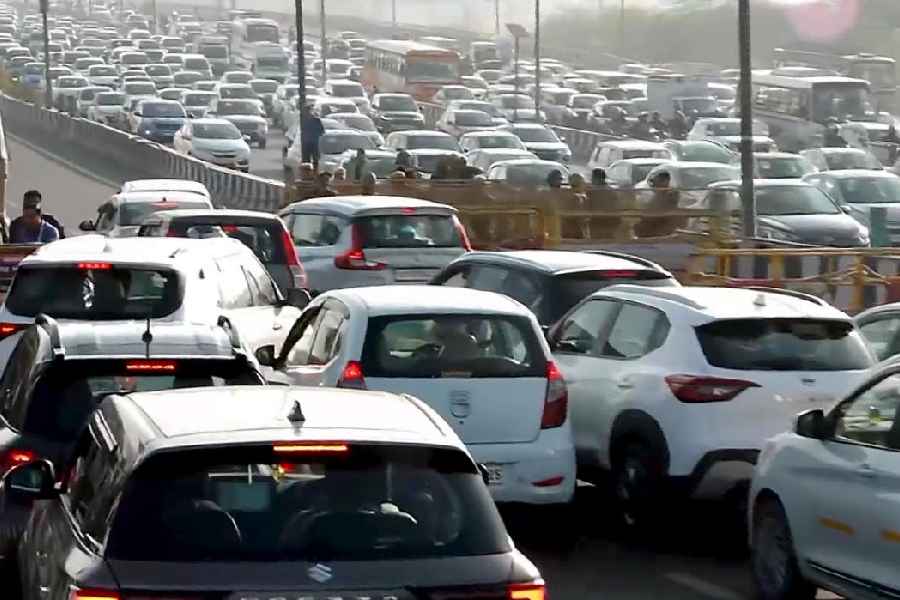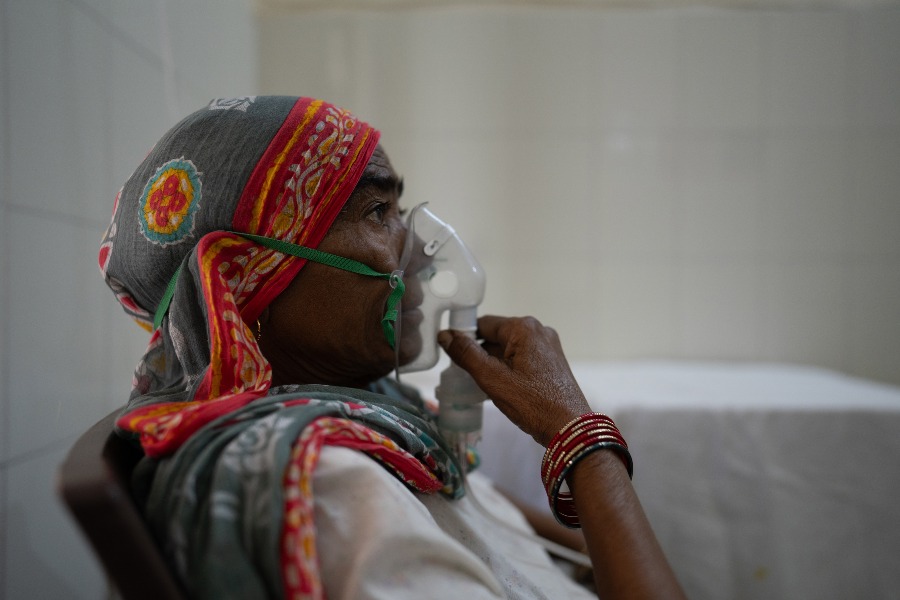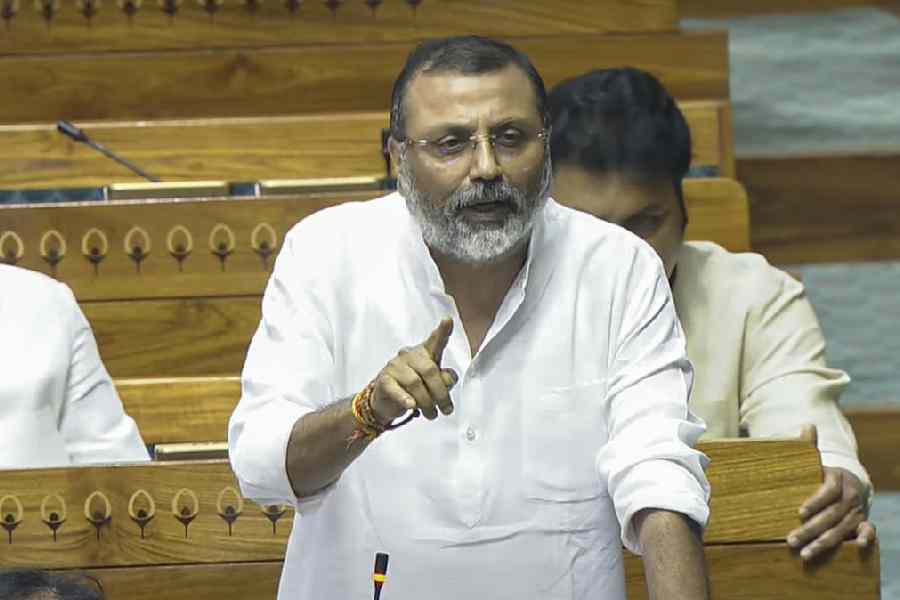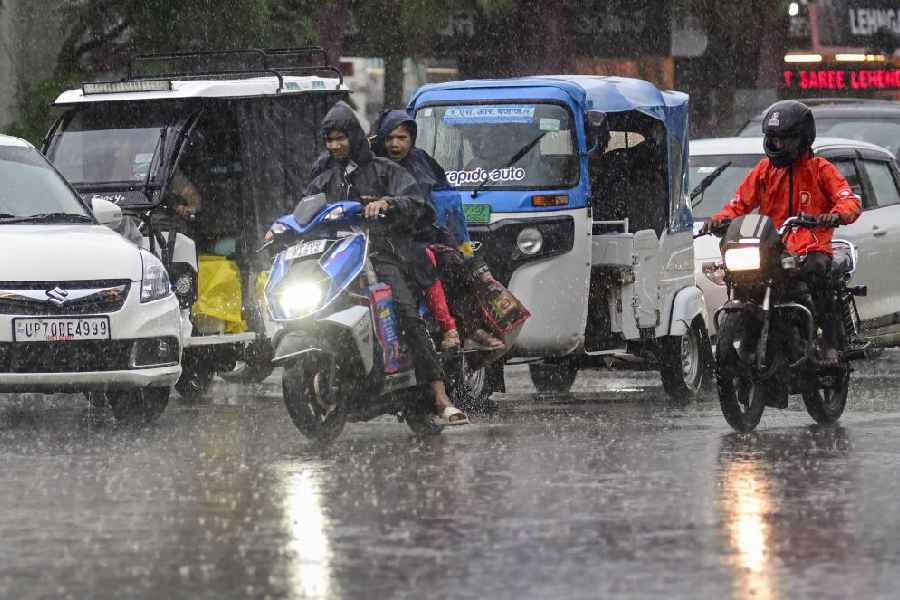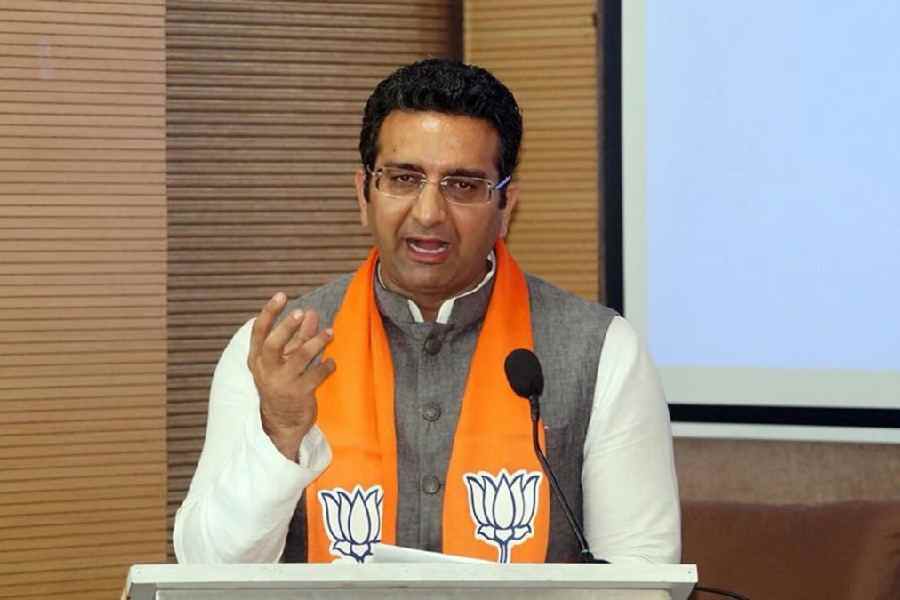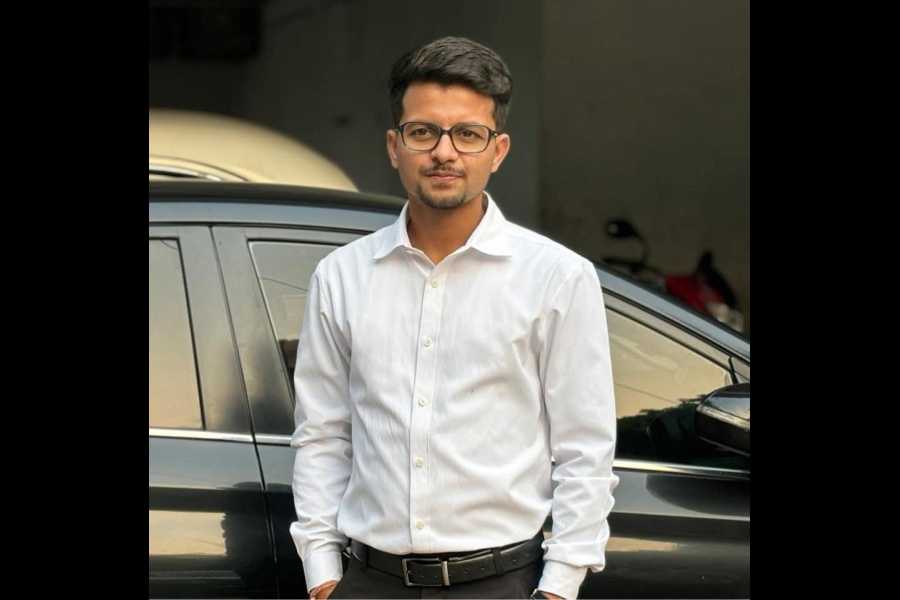|
|
| Border line: The fence along the Bangladesh border in Hingalganj photo: subhendu chaki |
Calcuttans beware — a terrorist or spy may be lurking in your neighbourhood. And you’d better take this seriously. One was found late last year in Howrah.
According to Gyanwant Singh, deputy commissioner of the Calcutta police’s detective department, police arrested late last year a Pakistani spy called Waquar Yunus with his local contact Ainul Haque in Howrah and seized a sheaf of documents related to the Indian navy. And when the city police contacted the naval authorities, they confirmed the seized documents were classified.
Now a deadlier threat looms over the megalopolis — terrorism.
Cut to Hingalganj, a block headquarters some 100 km from Calcutta. A ribbon-like road threads through the tree-clad villages on this island in the Sunderbans delta, empty of traffic except for an occasional motorcycle-driven cart laden with passengers, the lone local transport. At midday, the only sound you hear is the chirping of invisible crickets. Hingalganj, clearly, looks idyllic.
Suddenly, an armed Border Security Force squad emerges from a roadside bamboo grove. Further on, near what looks like a village square, another group of border guards marches by, fingers on the triggers of the guns hanging from their shoulders. In front of the local police station, a constable stands guard with an automatic rifle, an unusual sight in a rural police station in West Bengal.
But then, Hingalganj is not just another rural town in Bengal. Perched on India’s border with Bangladesh, Hingalganj, in North 24 Parganas district, is now a gateway to terror, a place the security forces and intelligence agents are keeping a sharp eye on.
Barely 24 hours before Independence Day, two Pakistani terrorists from the Jaish-e-Muhammed and Lashkar-e-Toiba were arrested at Charalkhali village, which falls within the ambit of the Hingalganj police station. Muhammed Sohail and Muhammed Zubeid confessed they had chosen to come via Bangladesh as it was the “easiest” route to get into Indian mainland. And that clearly means trouble for Bengal and the rest of the country.
In fact, the threat to Calcutta, barely a three-hour drive from the border, is all too real, police and intelligence officials believe. “It’s no longer a theory,” declares Calcutta police commissioner Prasun Mukherjee.
The city is clearly vulnerable to terror attacks, as the 2002 strike on the American Center amply demonstrated. The recent arrests, if anything, have only confirmed the suspicions of the intelligence agencies that Bengal is fast emerging as India’s newest terror hub. Mukherjee says the police “recognise the threat and vulnerability” of Calcutta as “it’s not very far from the border and has a mixed population.” Security experts cite other reasons as well. Tushar Talukdar, former city police commissioner, says militants from Bangladesh find it easier to blend in as they speak the local language and look like locals.
Security agencies say the militants are using Bengal chiefly as a “staging area” to carry out terror activities elsewhere in the country. At the moment, Delhi and Mumbai seem to be their main target. “Any attacks in Delhi or Mumbai will attract more international publicity,” an official says. Moreover, since they use Bengal as a “transit point” or “a hideout”, these groups, at least for now, don’t want to create trouble here. But this could change in the not-too-distant future as the security forces crack down on them in Bengal.
For militants crossing over from Bangladesh, it’s easier to travel to other cities once they get to Calcutta. Militants in India too are using the same route to escape to Bangladesh. In fact, the three masterminds of the July 11 Mumbai train blasts — Zahibuddin Ansari, Fayaz Kagzi and Rahil Sheikh, all from Maharashtra — are believed to have fled to Bangladesh via Calcutta after the blasts. “The Bangladesh border is playing havoc with our country’s security,” says Krish Pal Raghuvanshi, joint commissioner of Mumbai police and head of the anti-terrorism squad that’s investigating the blasts.
Ajai Sahni, executive director of the New Delhi-based Institute for Conflict Management, says terrorist attacks in several urban centres in the country over the past year have demonstrated that militants, trained in Pakistan and sheltered in Bangladesh, entered India through West Bengal. “This is increasingly emerging as an established modus operandi. This situation is serious,” Sahni says.
Not surprisingly, the focus of attention, as a Union home ministry official puts it, is fast shifting to the eastern border with an alarming rise in jihadi activities in Bangladesh. To be sure, India’s western border with Pakistan was for a long time the biggest bugbear for the Indian security agencies, with the armed militants slinking in under cover of darkness. But that was then.
Now, though infiltration remains a stark reality along the Line of Control (LoC) and elsewhere in Jammu and Kashmir, much of the border in states like Punjab and Rajasthan has been virtually sealed, with India erecting tall iron border fences to prevent infiltration.
Plugging the holes in the country’s eastern border with Bangladesh is far from easy, though. India shares a 4,095-km-long border with Bangladesh, with West Bengal accounting for some 2,216 km and the northeast the rest of it. And it’s not an easy border to watch or man, with a multitude of rivers flowing between the two countries in many areas. In fact, at Hingalganj, the Ichamati river divides India from Bangladesh.
“It’s an extremely porous border as much of it is riverine,” says BSF Inspector General Somesh Goyal, who is in charge of the force’s south Bengal frontier headquartered in Calcutta. Of the total 2,216-km-long border West Bengal shares with Bangladesh, only 643 km has so far been fenced. Worse, Goyal says that of the 504 km fenced area in south Bengal, 50 gaps — covering 92 km — remain as 187 villages along the border could not be relocated.
No wonder, then, that terrorist groups, from the Pakistan-based Jaish-E-Muhammed to the Bangladesh-based Harkat-ul-Jehad-al Islami (HUJI), are taking advantage of the situation. Compounding the problem, terrorists are “finding shelter among the sympathetic migrant population in migrant-heavy districts such as Cooch Behar, Malda, North and South 24 Parganas and Murshidabad,” Sahni says.
Security men agree. “To check terrorism, you need the full support of local people. That’s unfortunately not the case here,” says BSF inspector M.R. Thakur, the company commandant at the Hingalganj border outpost. Villagers, on the other hand, accuse the BSF jawans of harassing them.
Intelligence officials say the links between a section of the border population and the terror groups are too strong to ignore. The Asif Reza Commando Force, which claimed responsibility for the attack on the American Center in Calcutta on January 22, 2002 in which four policemen were killed, was formed at a village populated largely by illegal Bangladeshi migrants near Habibpur in Malda district in December 2001.
Apart from the American Center attack, militants sneaking in from Bangladesh have so far stayed clear of Calcutta following the “conventional terrorist wisdom that makes the militants keep principal points on their route relatively incident free,” as terrorism expert Sahni puts it.
Police are still apprehensive. With reason. The August 14 arrests of the Jaish-e-Muhammed and Lashkar-e-Toiba activists have exposed an intricate web of networks they are establishing in the country, with some of their email traced to Chennai. Alarmingly, the arrests have also revealed a “co-ordinated” effort being made by terrorist outfits to spread terror in India.
Terror elements are clearly taking root in Calcutta and its neighbourhoods. Following the December 31 busting of the espionage ring, Singh says the detective department on January 14 arrested Mohammed Tariq, a Lashkar-e-Toiba agent from Jamshedpur, with his two associates and seized 16 detonators from them. Tariq, trained in explosives in Pakistan, used to live in central Calcutta disguised as a honey trader.
Police officials acknowledge that the only way to combat the terrorists is to gather more intelligence about their activities. “They have contact points and contact persons. Those links need to be identified and snapped,” a detective department official says.
The chinks in the Bangladesh border, too, are glaring. Though 20 battalions are supposed to guard the border in south Bengal, only 17 battalions have been deployed. “Three of my battalions have been shifted to Manipur and Kashmir. I am short of men,” BSF inspector general Goyal rues.
Part of the terrorism problem is economic. Grinding poverty breeds crime in the border area, rife with the smuggling of cattle and the essential commodities Bangladesh is perennially short of. Krishnapada Ghosh, a CPI(M) member of the Hinganganj Panchayat samity, acknowledges that the block headquarters doesn’t yet have a hospital but a subsidiary health centre, where a paramedic on contract doubles as a doctor. Needless to say, the terrorist groups make the most of underdevelopment and those involved are not from any particular community. The man arrested for helping the Pakistani militants into Hingalganj on August 14 was Asim Mondal, a Hindu from Charalkhali.
Yet, in some ways, things are changing. Ghosh says work will soon start on a bridge over the Ichamati river to connect Hingalganj with Hasnabad, the nearest municipal town. “It will felicitate vehicular traffic and bring people closer to the mainland,” he says.
In Calcutta, the police too are gearing up to face the new challenge. Police commissioner Mukherjee says they have asked the home ministry in Delhi for a slew of pricey high tech security gadgets. And casting aside “one-upmanship”, all intelligence agencies are now regularly exchanging information they have gathered. “There is an unprecedented co-ordination among all the agencies,” Mukherjee says.
People, too, are becoming alert. In fact, a group of women first spotted the two Pakistani subversives at Charalkhali, leading to their arrest. After all, people power is what the security forces are counting on to keep Hingalganj and other areas on the border terror free.
‘WHAT WE FEAR MOST ARE DIRTY BOMBS’
The place: the Hingalganj border outpost. The time: a recent afternoon. A Border Security Force Maruti Gypsy trundles in. A compact man in uniform leaps out. BSF assistant commandant M.K. Verma is on an undisclosed mission. He heads a team of the National Disaster Response Force (NDRF), created chiefly to protect major cities from chemical, biological and nuclear attacks, apart from handling major natural disasters in the country.
The idea was conceived two years ago and the force, currently looked after by both the Union home ministry and the Prime Minister’s Office, is slowly taking shape. NDRF officials say the threat perception from Pakistan or China has gone down because of the changed global geo-political and economic scenarios. “The real threat to our cities now comes from the jihadis operating from Pakistan and Bangladesh. What we fear most are dirty bombs, nuclear or similar weapons acquired by fundamentalist terrorist groups,” an official says.
So far eight units of the NDRF, staffed with men from the BSF, Central Industrial Security Force, Central Reserve Police Force and the Indo-Tibet Border Police, have been set up in as many cities, including Calcutta, Delhi, Chennai, Pune and Guwahati.
Members of this elite force are at the moment being trained at the Bhaba Atomic Research Centre, Mumbai, in nuclear, biological and chemical warfare. “We will get cracking soon,” an NDRF official says.



